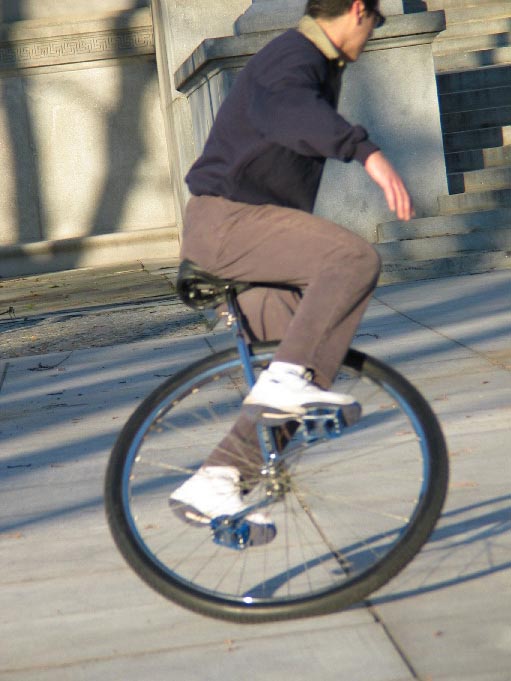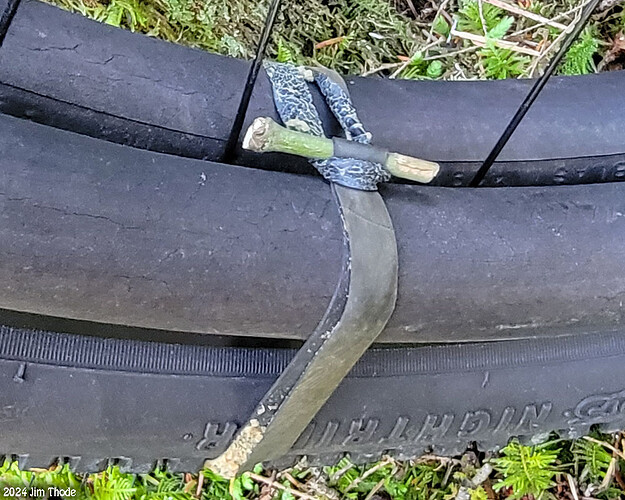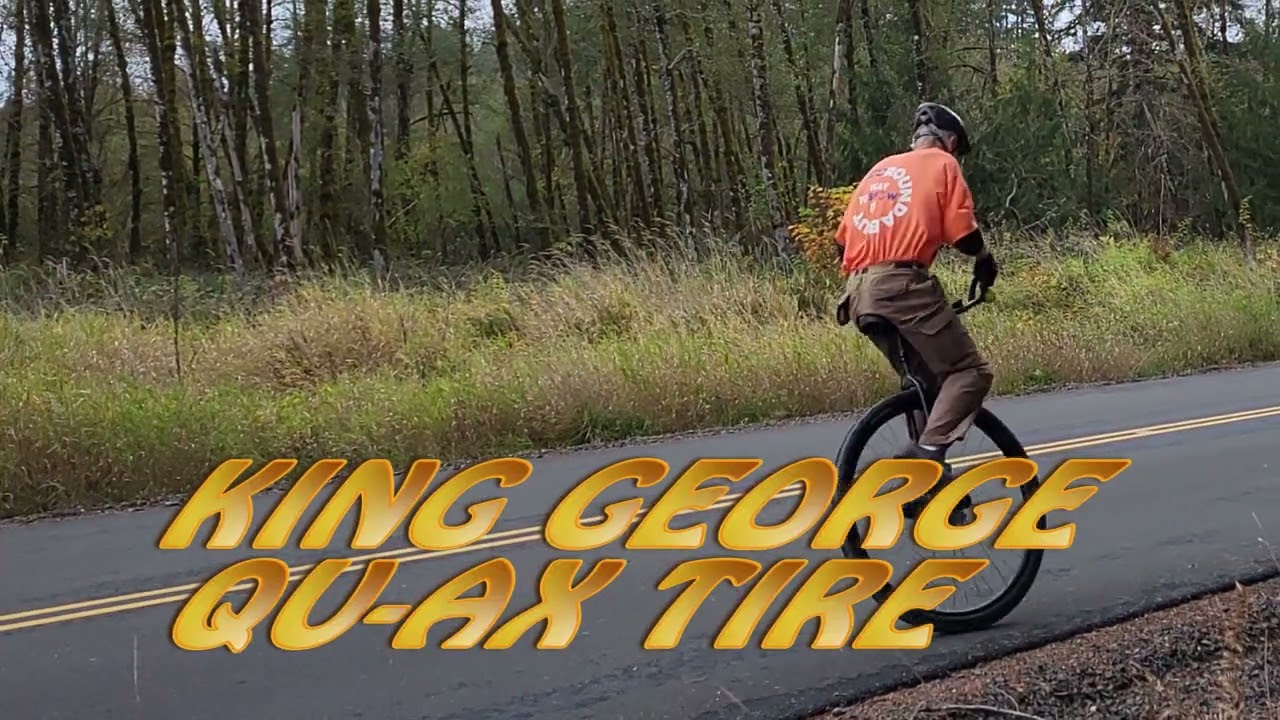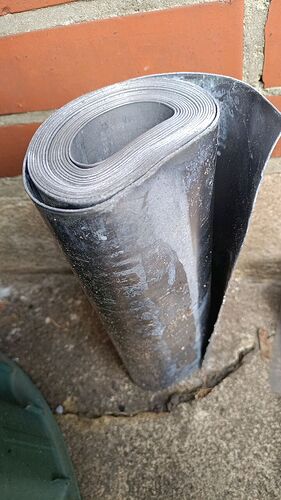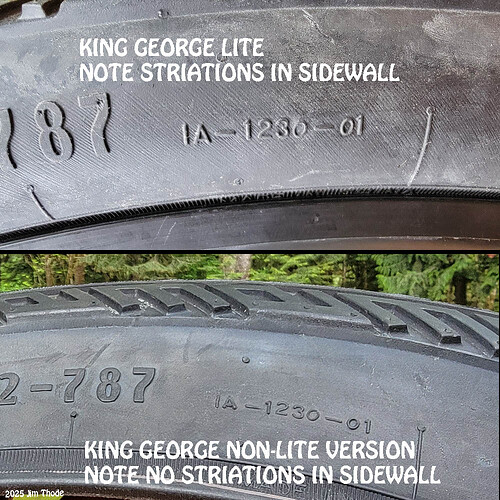It‘s funny how sometimes people experience the same thing very differently - I keep having the impression that this tire is quite insensible to camber… Just had this very thought on a ride today (okay, it‘s 36“ vs. 32“, but I doubt that it makes a huge difference).
Maybe it‘s all about the pressure. You mention the high pressure, while I‘m riding at somewhere between 2 and 3 bar, probably closer to the lower end of the range (that would be something around 30psi).
Thank you, Jim!
I have been a little unimpressed with my ability to perform graceful/smooth turns on my 36”, but kept blaming myself when part of the issue may in fact be my tire. I can only continue practicing, but may not be as hard on myself in the future.
The lighter sidewalls on the NR Lite, and slightly thinnner rubber in general means that at low pressures (pressures that might have been absolutely fine on the older NR) it likes to go into corners and not come out of them very easily as the sidewalls start to deflect, but at higher pressures maintains a more rounded profile which is generally better on camber than the non lite version.
At 30PSI I’m quite surprised you find it an acceptable riding experience. How light are you?
Back to the original topic, my personal experience does not align with Jim’s findings, and every single thing I’ve done to reduce the rotational mass of the wheel has been an improvement for me.
I agree with others that much of this is likely down to the type of routes ridden. My riding is mostly semi-urban, with periodic short and sharp hills and a lot of stops for lights/crossings etc.
Acceleration, deceleration, and easy manoeuvrability is therefore really important to me.
Back when the NR Lite came out, I ended up getting mine in a trade with my old NR as the other rider preferred the feel of the additional rotational mass of the old tyre and how it handled in general. Their riding was typically in Cambridge (UK), where there’s pretty reasonable connected cycle infrastructure and it’s flat as a pancake compared to here in Leeds.
I think they’ve since moved to a NR Lite and a carbon rim though.
I’m in love with my new NR Lite that I’ve been riding for the last year.
I don’t notice any camber difference or any other handling differences.
To me, it just feels like riding my 29+ only I’m on a 36".
I’m 187lbs and ride with 23psi for my cross country trail riding.
A very insightful answer. I haven‘t observed that behaviour. In fact, I wouldn‘t mind to be able to take narrow corners more easily. But I think this leads back to the subject of weight and inertia. Which leads us to:
I think including the 36er, the weight of the whole system is around 70-75kg, sometimes more, depending on what I wear and what‘s in the backpack.
30psi was just a guess. But I do indeed ride at comparatively low pressure on pavement, mostly because of my laziness. I usually do pump the tire to something around 3bar (back when I was younger many tires for my touring bikes wouldn‘t take a lot more pressure anyway). Then I usually ride until it‘s not fun anymore. This is often around 1.5bar or less.
So I‘m used to the „comfy“ ride of underinflated tires. If I pump them harder the ride becomes too rough for my taste.
Thanks for the info. I have been wondering about that for a very long time. When I got my first night rider, I was breaking 3 to 5 spokes a ride. I replaced them by myself and still broke lots of them. I went to a bike shop and had them replace my spokes and broke a bunch more. I finally switched to my old airfoil rim from my original Coker. It is very heavy. I have put on a few hundred miles with no broken spokes at all. I’ll stay with the heavy rim thanks to your experiment.
Great discussion, and thanks Jim for sharing your experiences with an extra heavy wheel! While reading your detailed description of setup and the ride, I assumed your route was pretty flat. Nope, 600’ (roughly 200m) of up, and you didn’t mind the extra weight? That made me curious. I think you said the extra weight seemed to make it easier to maintain your momentum, with less need to make corrections. Sounds about right.
I am reminded of a tire weight “experiment” that was done in 1979 or so. Floyd Crandall, of the Pontiac Unicyclists of Michigan (a unicycling track star for many years and initial holder of the Guinness 100m record in 1980), and Cathy Fox, of the Paul Fox Unicycle Club of Marion, Ohio, both decided to attempt a century ride and possible Guinness 100 mile record for unicycles. Floyd Crandall had an Amish wagon wheel unicycle, with a hard tire on an all-wood wheel; a unicycle weighing 40-50 pounds. Cathy Fox had a 40" Tom Miller Big Wheel (it wasn’t called the Unicycle Factory untion 1984). This weighed around 25 pounds. These unicycles were made with hand-bent, strong Schwinn Tubular rims, and gray wheelchair rubber for the tire.
Long story short, Floyd pooped out and didn’t complete the 100 miles. Cathy completed the distance, I think around 11 hours or so. She later appeared on the American TV game show To Tell the Truth, as a person who rode 100 miles in a day on a unicycle.
I’m going to assume this was a pretty flat ride, by design, and doesn’t prove anything other than that riding a VERY heavy wheel is going to use quite a bit of energy to manage over such a long distance. I’m sure fitness was also a factor. Floyd was the fastest unicyclist every year for the Track races at the National Unicycle Meets. Cathy was also fast in those short races. This doesn’t have much to do with a 100-mile ride, as the longest race for unicycles at the meets was one mile. But it’s an interesting story.
I imagine the flatter the route, the better you might like a heavier wheel. Especially if you’re not dealing with traffic, or having to stop and start much. Then, as the need to change speeds as well as climb and descend, the less you might like having that extra weight onboard. My old commute to work (flat, lots of bike path) would probably be a good ride for a heavy wheel.
I ride mostly Road and Muni. Most of my rides involve lots of ups and downs, making a heavier wheel less helpful. Especially for Muni, where there are constant speed changes for varying terrain, and plenty of short and long climbs, sometimes steep!
That’s a very interesting method for adding weight to a rim!
I have posted about wanting to build a heavier wheel 36er because (1) I can’t bank turns on my standard rim Coker as severely as I was able to on my old, heavier, steel-rim Coker that I sold to actor Mike Arotsky and (2) I am very eager to get back into skatepark riding, but I won’t do it unless I have what I call a “HI” (High Inertia) 36er. I need to be able to store adequate energy in the wheel in order to do the riding I enjoy most.
I had a LOT of fun being able to make those highly banked turns (like the one in the attached photo). Unknowing spectators often thought I was about to wipe out, only to realize that I was merely turning.
I already had UDC build me a 36" wheel with cranks and I bought a frame and most of the other needed components, so with some luck perhaps my dream of riding a High Inertia 36er again may come true.
My initial plan was to wrap a couple layers of weighted taped (used for golf clubs) on the insider of the rim and then enclose the tube inside another tube that I cut open and use just for the added weight. That would give me an additional 5 pounds or so if my memory serves me, but I am hesitant about this method because it’s bot a simple solution and if the tape and/or added tube interferes with the tire fitting on the rim properly, it may be quite a process to remove all the tape.
Jim’s method seems like it could be the answer, but I have one main concern:
I do pivot turns very often when riding on the streets and at skateparks. I think the friction from such turns (as well as banked turns, but probably to a lesser extent) will cause one or more of the tire bungees to deteriorate and fail. At the skatepark, I can select a line and then just ride that one line before taking a break to select my next line, so it may not be too much of a problem because I can check the wear on the bungees often and replace them when needed. When riding on the streets, I suppose I’d just have to carry some extra bungees with me and check the status of the ones on my wheel every so often.
The prospect of having a High Inertia 36er soon is very exciting to me! Thanks for this great idea, Jim. My dream of returning to the kind of unicycling I love most may be closer to reality than I realized. I found half-inch rubber tubing on Amazon that will add about 3lbs per side, for a total of 6 pounds. Although a bit heavier than I was planning, it may be fine. At the very least it would be a good starting point.
@JimT Did you use a 36er tube to make the bungees? It looks like you used screws to secure the bungees together, is that correct? Any input, tips, or suggestions from you (or anyone else who feels like replying) would be most appreciated.
Thanks again, Jim! Your ingenuity could be a game changer for me.
@HardcoreCokerRider , that photo is very impressive, as are some of the turns I’ve seen you do on video.
If you had to estimate, how many times do you think that type of turn ended badly for you while you were learning to turn like that? Also, how bad was bad? Or, did you just creep up to that type of turn slowly without any negative consequences?
I used car tire sized inner-tube with little sticks to lock the ends together. For longer use other then just testing I would be concerned about wearing through the bungees.
Also for your use I’d highly recommend a tire other then the Nightrider Lite. I went from a Nightrider non-Lite version that cornered very nice and smooth to a Nightrider Lite and the difference in cornering was night and day. The Nightrider Lite does not turn well at all. I ended up with a King George tire that does turn very well just by leaning into the turn. The King George I have mounted now is a lite weight version and I don’t know about the heavier version.
This video shows the difference the tire can make. No weight was added for this comparison. For your faster tighter turns the King George tire should work well.
Wow! That is a huge difference! Thank you for posting @JimT !
You may be able to make it heavier by using automotive wheel weights
I would try lead foil (used for roofs) as rim tape. Can be cut easily to long stripes.
This was 30cm x 3m, even this rest is hard to lift.
If you have extra you can wrap it around the spokes
The graphics where it shows the part number is not 100% guarantee that is is the light weight version. Innova who are the factory that now make the tyres make both the standard and light weight versions.
It seems that the markings on the lite and non-lite versions may be exactly the same. Looks like the only way to tell without weighing is by looking closely at the sidewall. This is the King George but I’d guess the Nightrider is the same.
Thanks @Uni2ONE2!
I don’t remember my highly banked turns ever ending badly while I was learning, or ever at all. Subsequent to mastering the maneuver as best I could, there were a few occasions when the wheel did come out from under me rather suddenly, but I always landed on me feet, so that’s the reason I don’t consider those times as having had bad outcomes. Of those few occasions when the wheel came out from under me, there were at least two times that the unicycle did go flying across the street. Considering that I live in Manhattan, and at the time was living in one of the touristiest and crowded neighborhoods in the City, I was quite lucky that my unicycle didn’t hit a pedestrian, cyclist, or slam into a car. So in that sense, I suppose I had good outcomes, even when things went bad.
As far as my progression when I first started learning the turn, I do remember thinking that it’s the type of maneuver that requires some speed, so I was going at a fairly decent pace when I tried it the first time. It worked out surprisingly well and I thought it felt incredible, so I kept at it and got better. You don’t need a ton of speed, but you also can’t be too slow. While I can bank turns half-way decently on my lighter Coker, I don’t believe I have (or ever had) the skill to do my most severely banked turns unless I have a unicycle with a heavy enough rim. Having a heavy rim that can store a lot of energy is the key! With a heavy rim 36er I think anyone can learn to do severely banked turns. With the standard weight 36ers, like most that are available these days, it is much more difficult to bank them over as much.
@JimT Thanks for the information about the bungees you used, your tire selection tips, and the close-up photo of the bungee. It’s very helpful.
I have an old Coker button tire that is nearly bald, so it barely has any buttons left, a Wheel TA tire that seems almost new, and a brand new Nightrider Light tire. Depending upon how much weight I add to the rim, I’ll use either my old, bald Coker tire or my Wheel TA tire. The Wheel TA tire is the heaviest. That’s a bummer that the Nightrider Lite doesn’t perform so well.
Given my concern about wearing out the bungees, I would ideally prefer my weighted tape & extra tube method since it is internal and I won’t have to worry about bungees breaking. However, I’m not certain if it will work, so your method could wind up being my best option. If I go the tube & bungee route, I guess I’ll just have to bring extra bungees and fasteners along with me when I ride and check the bungees every so often to see their condition and replace them as needed. I suppose I would use more bungees than you did (for an extra margin of safety) since I would be going for rides beyond just testing.
So now my plan is to bring the wheel I had built to my local bike shop, along with some of the weighted tape I’d like to layer on the inside, in order to ascertain whether they think they’ll still be able to get the tire on the rim once I’ve taped it up.
I looked into that previously @Nathan_Moore but it seems like they are fairly light so I would need to install a lot of them to add the amount of weight I want to have, plus the closer the weight is to the outside of the circumference, the greater the flywheel effect, and that’s what I’m seeking.
Thanks @Ulkicycling, but I already purchased the weighted tape, so I will try to use what I have. It was readily available in the amount I need and it’s easy to cut, so it’s also probably the easiest method of that sort for someone like me, who’s not really a DIY guy.
I was wondering. Here you primarily make the 36 heavier, but what about a smaller wheel. Would one-footed riding be easier on a heavy wheel that nearly rolls by itself because of the weight. The wheel would pull itself through the deadpoint
On a 36er, a heavier wheel is much easier to ride with one foot. I would imagine a heavier small wheel would also be easier to ride one-footed, even if to a lesser extent than a 36er.
One thing that I’m curious about is the idea of somehow attaching a flywheel to a smaller wheel. Think having a big cog attached to the hub and somewhere on the unicycle have a small cog fixed to a hefty flywheel. That way the wheel can have the effect of having more inertia without having to strap weights to the wheel. Feasible? I don’t know. It probably wouldn’t look too pretty. But it might be a fun idea to play around with as a novelty ![]()
